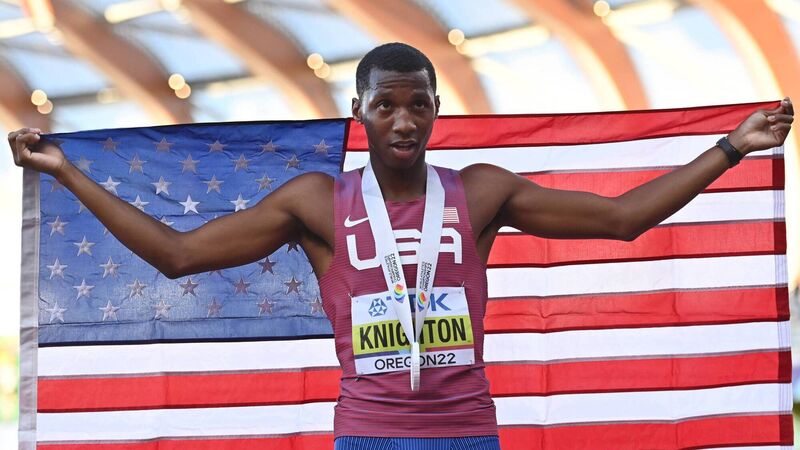Cathal Dennehy: Athletics Integrity Unit's scorched earth policy paying off in war that can't be won

Erriyon Knighton tested positive for a steroid he said came from eating oxtail, but after being cleared in the US, the AIU and WADA appealed and CAS handed him a four-year ban. Pic: Sam Barnes/Sportsfile
It was one of the biggest shocks at the World Athletics Championships: France’s Jimmy Gressier kicking to glory in the men’s 10,000m. But in Tokyo that night, what he said in the mixed zone was just as notable as how he performed on the track.
“Today, I beat East Africa. Let's not kid ourselves, you know I'm not picky, the AIU (Athletics Integrity Unit) is doing a huge job and it helps to level the playing field a bit more.”
The 28-year-old has been on the global stage for several years, and his inference seemed clear: in a past era, that same performance would likely have come up short against dopers.
At a press gathering with the AIU during the championships, Gressier’s comments were relayed to David Howman and Brett Clothier, the chairman and head of the AIU. “That’s really gratifying to hear that athletes are appreciating what we’re doing,” said Howman, who previously spent 13 years as Director General of the World Anti-Doping Agency (WADA).
As Clothier added: “We’re pleased that athletes feel there’s more of a level playing field. I’ve worked in lots of other sports and in this sport, the athletes, officials, support personnel, actually take the integrity of the sport very seriously. When we have (doping) cases, it’s not looked at as a bad news day. We’re encouraged by people in the sport to keep going, to keep doing our job.”
It's eight years since the AIU was set up and it operates independently from the sport’s world governing body, ensuring no repeat of what played out under disgraced former president Lamine Diack, who along with other senior figures in the sport was convicted of accepting bribes to cover up positive tests.
It's hard to overstate how far the sport has come since in its war on doping, which for a long time was really more of a facade. Talk to those entrenched in athletics a few decades ago and you’ll hear stories of star names who could buy their way out of positive tests. But since its formation, the AIU has taken a scorched-earth policy to cheats, with no name too big to fail, no flurry of positives from one nation too damaging from a PR perspective and no decision by arbitration panels to clear athletes above an appeal to the Court of Arbitration for Sport (CAS).
“Finding the actual cheats, that’s what we’re here for,” said Howman. “Getting the people who are intentionally defrauding other athletes out of priority positions, money, sponsorships – out of enjoying the moment when they succeed.” One of the doping hotspots in global athletics today is Kenya, which finished second in the medal table in Tokyo with seven golds. The AIU has suspended around 140 Kenyans since 2017, among them current women’s marathon world record holder Ruth Chepngetich. But Clothier is keen to stress that each positive test is good news for the future of Kenyan athletics.
“Before this project started, a huge chunk of that period, there was no testing at all, basically,” he said. “It was completely the wild west – it was a very, very bad situation. It had to be addressed, structurally, and it has been addressed. We have more cases (now), but less doping. There are more deterrents, people are getting caught, people have to be more careful. There's absolutely less doping today than there was five years ago, but there's still a lot of doping in Kenya. There's a long way to go and we have to keep working on it.”
Ahead of the World Championships, Kenya’s Anti-Doping Agency (ADAK) was deemed non-compliant by WADA, which Clothier said was a “wake-up call”, adding that authorities there “can’t take their foot of the pedal”. But the AIU has worked closely with ADAK to bolster its impact and Clothier says the system is now much stronger. “There’s been a huge amount of progress the last three years or so, going from 400 out-of-competition tests (a year) to 4,000. They had 30 athletes in their registered testing pool; now they have 300. But the compliance issues they have right now are not good enough. For the integrity of our sport, we need the anti-doping agency to be at that level.”
Another high-risk area for doping is the US collegiate system, the NCAA, where proper drug testing remains virtually non-existent. Despite its non-compliance with the WADA code, World Athletics still recognises NCAA results for qualification purposes for major events.
“They're a private organisation in the United States which doesn't come under the auspices of US Anti-Doping,” explained Howman. “We can conduct testing on those athletes who are in our registered testing pool, and we do.” Clothier didn’t have the figures to hand on how many NCAA athletes are in that testing pool but said it’s “curious that the results are recognised”, adding: “It's not our job to go in and fix that problem, but it's a very high risk factor we look at that could affect international competition.”
When the AIU has felt decisions by arbitration panels used by national anti-doping authorities have been unsatisfactory, it has challenged them at the Court of Arbitration for Sport (CAS) and two such cases occurred ahead of the World Championships concerning Ethiopia’s Diribe Welteji and US sprinter Erriyon Knighton.
Welteji, who won silver in the 2023 world 1500m final – demoting Ciara Mageean to fourth – was blocked from competing in Tokyo and provisionally suspended for allegedly refusing to take a drug test despite being cleared previously in Ethiopia. Knighton, meanwhile, tested positive for a steroid last year but was cleared after an arbiter in the US accepted his explanation that it came from consuming oxtail. But the AIU and WADA appealed that to CAS, which banned him for four years.
Howman admitted the AIU may be “more aggressive” in dealing with suspected food contamination cases and he stands over their decision to challenge such rulings: “It’s like the rest of life. You don’t sometimes get the decision which, in our minds, is the proper one at first instance.” When asked about anti-doping in team sports, Howman said “out of competition testing has not been solved”, adding that drug testing in football is “certainly not based on what we would call intelligent testing.”
Given the trend in modern doping is to micro-dose substances, leaving behind very short detection windows, Clothier said the AIU’s testing is “planned to the day and even to the hour”, adding: “The sport's come a long way. We're not seeing very powerful doses used so the advantage from doping is getting less and less. That's not to say it's stopped.” Howman said the difficulty across anti-doping is “a brick wall of resource – the money is actually drying up rather than increasing” but he feels they’ve made significant gains in athletics.
“We'd say there are fewer contests where the integrity of the competition is being damaged. One way you could look at that: how many people from countries that haven't won medals before are now winning medals? The playing field is getting more level. We want to continue to do better, not just sit on our laurels.” As Howman and Clothier know, it’s a war that can never fully be won – the lines of battle ever-shifting, the cops-and-robbers chase never ending. But it’s clear that things are better than they once were. And while some cheats are undoubtedly still slipping through the net, clean athletes are now facing a much fairer fight.



